![]() 1st Battalion 22nd Infantry
1st Battalion 22nd Infantry ![]()
THE TWENTY-SECOND REGIMENT OF INFANTRY
By CAPTAIN OSKALOOSA M. SMITH, C. S., U. S. ARMY. (LATE FIRST LIEUTENANT 22D INFANTRY.)
(Part Two)

General disposition of elements of the 22nd Infantry 1866-1896
In March, 1877, Companies G and H marched through deep snow to Tongue River, joining the garrison at that place for duty.
On April 30th, Companies E, F, G and H, together with two companies of the 5th Infantry, four troops of the 2d Cavalry and Lieutenant Casey's scouts, made up of men of the 5th and 22d Infantry and a few civilians, marched under command of General Miles from the cantonment, the object being to attack a renegade band of Indians, chiefly Minneconjous, under the leadership of Lame Deer, which was camped on the Rosebud. over 100 miles distant by the detour which it was necessary to make. At a point on Tongue River, sixty miles from the cantonment, the train was corraled and left under guard of Companies E and H, 5th, and G, 22d Infantry; the scouts, Troops F, G, H and L, 2d Cavalry, and Companies E, F and H, 22d Infantry, with a few pack-mules to carry ammunition and rations, cut across the Rosebud, moving up that stream, and after a very hard march with scarcely a halt during two nights and one day, early on the morning of May 7th surprised and attacked the Indians near the mouth of Muddy Creek, now called Lame Deer, an affluent of the Rosebud, a beautiful valley where the Northern Cheyenne Agency is now located. Lieutenant Casey, with his detachment closely following him, was the first to dash through the slumbering camp, surround and take possession of the herd of 450 ponies. He was quickly followed by Lieutenant Jerome, who headed a troop of the 2d Cavalry, then followed the rest of the cavalry. The Indians opened fire, which was responded to by the troops. As soon as possible they were called upon to surrender. Lame Deer and Iron Star, his head warrior, appeared desirous of doing so, but the Indians again commenced firing upon the troops, which ended the peace-making; the fight was resumed and they were driven from the camp. Fourteen of them were killed, including Lame Deer and Iron Star, 450 ponies and the entire camp fell into the hands of the troops, among whom there were several killed and wounded.
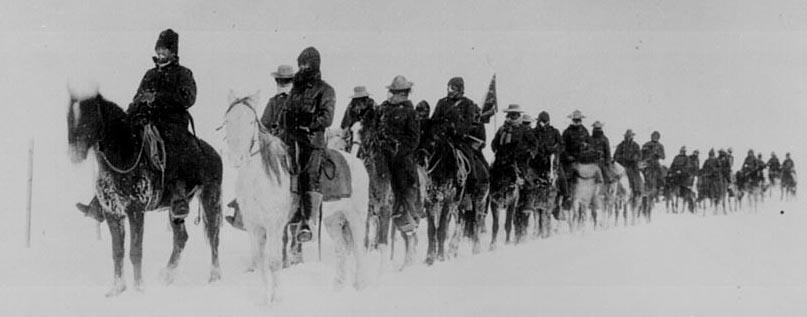
LT Casey's Indian Scouts on winter campaign
The battalion of the 22d hearing the firing in front, quickened its march, arriving upon the scene shortly after the engagement and immediately took posts surrounding the camp. Firing between the troops and Indians was kept up the entire night, so there was very little sleep in camp. The next morning after burning the captured camp, the troops started back toward Tongue River, every infantry soldier being mounted on a captured pony, besides which there was a herd of them to be driven. That night the Indians made another attempt to recapture their ponies, but they were driven off by the rifles of the troops, and the ponies were successfully taken in to the cantonment, where they were used for several years in mounting the infantry.
Company E returned to the cantonment, but F, G and H made a scout, in company with the 2d Cavalry, toward the Little Big Horn, returning to the cantonment May 31st. Companies I and K left Glendive May 25th, reaching Tongue River by steamer on the 27th, and soon thereafter the battalion was again consolidated under command of Colonel Hough. About this time however it was understood that the Indian hostilities had ended and that the 22d would return to its eastern station. Colonel Hough was ordered to his post, Fort Mackinac, and the companies, under command of Col. H. M. Lazelle, 1st Infantry, together with a troop of 7th Cavalry and two companies of the 1st Infantry, left by boat June 16th, arriving at the mouth of Powder River the same day, thence a long scout was made toward the Black Hills country. The trail of Lame Deer's band was struck and followed in a northerly direction for several days, the troops getting so close upon the band at one time that the scouts under Lieutenant Casey were attacked by a large number of them, one Indian being killed. Their camp was located in the bad lands of the Little Missouri near Sentinel Buttes, to which place the expedition made an all night march but the Indians had taken the alarm and escaped. At that point Colonel Lazelle relieved the battalion, and under command of Bvt. Major C. J. Dickey, it made a famous march to Fort Abraham Lincoln.
Upon arrival at Lincoln we were made glad by an order to proceed to our stations by steamer from Duluth, but before the symposium which was necessary under such good news was finished, the order was changed and the battalion was directed to repair forthwith to Chicago to aid in suppressing the railroad riots, where it arrived on the 25th and again fell under command of Colonel Hough. It remained there several days, until quiet was restored, being stationed in various parts of the city, and was then ordered to Wilkes-Barre, Pa., owing to the disturbed condition of the mining districts. The battalion then under command of Colonel Otis consisted of Companies A, B, C, half of D, E, F, G, H, I and K. They remained there until October when they were ordered to their proper stations. During the time from August, 1876, to July, 1877, the battalion that went to Montana marched upward of three thousand miles.
In 1879 the regiment was ordered to the Department of Texas and started for that department in April. While en route, on account of some Indian difficulties, Companies D, E, F and K, under command of Colonel Hough, were ordered to take station at Fort Gibson, Indian Territory, and the other companies would no doubt have been stopped also, but they were in advance and had already reached Texas. The colonel, lieutenant-colonel and Companies B, C, H and I were assigned to Fort McKavett, A to Fort Griffin. Fort McKavett was made sad and gloomy July 4th, by the death of Capt. T. H. Fisher, a very popular officer in the regiment. Early in the summer Company E went to Vinita, I. T., and K to Coffeeville, Kansas, where they remained until October, for the purpose of keeping boomers out of Oklohoma and to protect the inhabitants from the robbers who infested that part of the country.
In the fall of 1879 a general war with the Ute Indians in Colorado was anticipated and the companies at Gibson under command of Col. Hough were ordered to go there. They went to Alamosa, Colorado, by rail, thence they marched over the mountains to Animos, where, together with two troops of the 9th Cavalry and four companies of the i 5th Infantry, they went into a camp of observation under command of Col. G. P. Buell to prevent the Southern Utes from joining the Northern Utes at Ouray. In January, 1880, the companies of the 22d were ordered back to Gibson, and on account of deep snow in the mountains, they were compelled to march to Santa Fé, New Mexico, where they met with a grand ovation. From that place they went by rail to Gibson, having marched over five hundred miles. From Fort Gibson they went by rail to San Antonio, Texas, where Company E took station, Companies D and K marched one hundred and twenty-six miles to Fort Clark, where they took station, regimental headquarters and Company H having some time before been ordered to that post.
The regiment remained in Texas, serving at several different posts, and doing much scouting, until November, 1882, when it was ordered to the Department of the Missouri; Headquarters and Company E at Santa Fé, N. M.; A, Fort Garland; B, G, H and K, Fort Lewis; C, D, F and I, Fort Lyon, all in Colorado.
The regiment campaigned and changed stations a good deal in the Department of the Missouri until May, 1888, when it was removed to the Department of Dakota, Headquarters and Companies A, B, C, D, F, H and K taking station at Fort Keogh, Montana, E and G at Fort Totten and I at Fort Abraham Lincoln, Dakota.
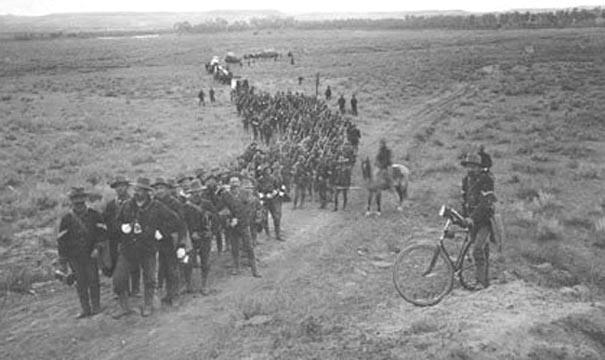
The 22nd Regimental Band, followed by
Companies F, G and H, outside of Ft Keogh, 1895
Bicyclist is identified as PVT Ramsey, Company F.
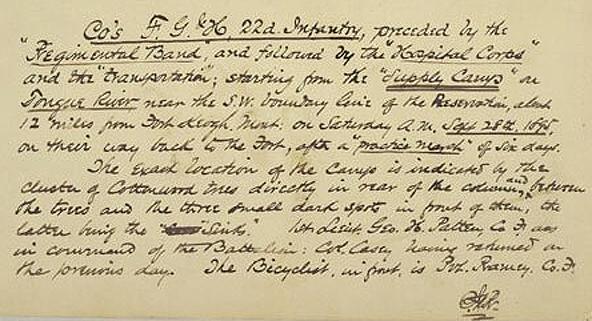
Description on back of picture above
The companies were not in the "coffee cooling business," but were from time to time scouting or camping at agencies where the Indians were restless or were thought to be preparing to go upon the war path. In the latter part of 1890 there was an uprising of the Indians at Pine Ridge and Rosebud Agencies, South Dakota. Companies A, B, D, G and H were ordered into the field and campaigned more or less all of that winter, sometimes in very inclement weather. Company D, under command of Lieut. J. G. Ballance, made an extraordinary march to the relief of Captain Fountain's troop, 8th Cavalry, reported to have been surrounded by 500 Indians at Cane Hills, South Dakota. On December 23d, at 7.45 P. M. it started upon its march in a wind and snow storm, from Beisigl's ranch, reaching New England City, a distance of 63 miles, at 1 o'clock A. M., the 25th, 293 hours; it was necessary to make a halt there to rest and thaw out the half frozen men. In a few hours the march was continued 22 miles, when a portion of Captain Fountain's troop was met, which reported the safety of the troop, and the company then returned to the New England City. In the meantime Companies C and K had hard tours of duty at the Cheyenne Agency, Montana.
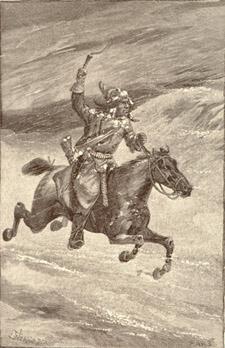 Bringing News of Lieutenant E.W. Casey's Death by J. Steeple Davis
|
In December, 1890, Lieut. E. W. Casey, who commanded a company of Cheyenne scouts which he had organized by authority of the War Department under plans originated by himself, marched from Keogh to the theatre of hostilities, and on January 7, 1891, was camped on White River, near the mouth of White Clay Creek, not far distant from the Pine Ridge Agency and the hostile camp. Early that morning several of the Sioux had entered his camp and held a friendly talk with him. At 9 o'clock he started out with two of his scouts to examine the hostile camp and when within a short distance of it was brutally murdered by a Brulé Sioux (Plenty Horses) belonging to that camp, who, in a cowardly manner, shot him from the rear. Casey was a brave and energetic officer and an enthusiastic friend of the Indian. He originated the plan of organizing them into military companies, believing that by it much would be done to elevate and civilize them and looked forward to the realization of his efforts. He died before he had reached the meridian of his strength, full of intellectual vigor and generous impulses, and as most of us might wish to die—in harness. It was some time after the close of hostilities before the companies returned to their stations—July, 1891, found them all back at their posts. (Editor's note: Plenty Horses was
aquitted of murder charges, since it was sucessfully
argued that the Sioux were
Lt Casey and his scouts, Ft Keogh 1890 |
Pursuant to G. O. 76, Headquarters of the Army, July 21, 1890, Companies I and K ceased to exist. The officers were assigned to companies, replacing absent officers, the enlisted men were transferred to other companies and the company records were laid away in the archives of the adjutant's office. Company I has since been resuscitated and is now being recruited as an Indian company.
During its varied service the 22d has come in contact with nearly every regiment in the Army and its relations with other troops have uniformly been pleasant. It has always been a regiment of great espirit de corps and the officers are proud to have the number of the regiment upon their commissions. Under the Act of Congress approved October 1, 1890, no more commissions for the regiment will be issued, an officer will be in the 22d Infantry by assignment only and may be transferred to another regiment at any time.
The entire regiment is now stationed at Fort Keogh, Montana, the first time it has ever been united at a post.
Captain Smith's account is part of the collection of the US Army Center for Military History
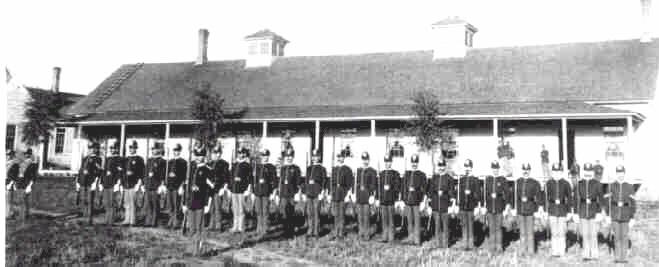
Company A, 22nd Infantry Regiment, Fort Lewis, NM 1885

Indian Wars Campaign Medal
Home | Photos | Battles & History | Current |
Rosters & Reports | Medal of Honor | Killed
in Action |
Personnel Locator | Commanders | Station
List | Campaigns |
Honors | Insignia & Memorabilia | 4-42
Artillery | Taps |
What's New | Editorial | Links |